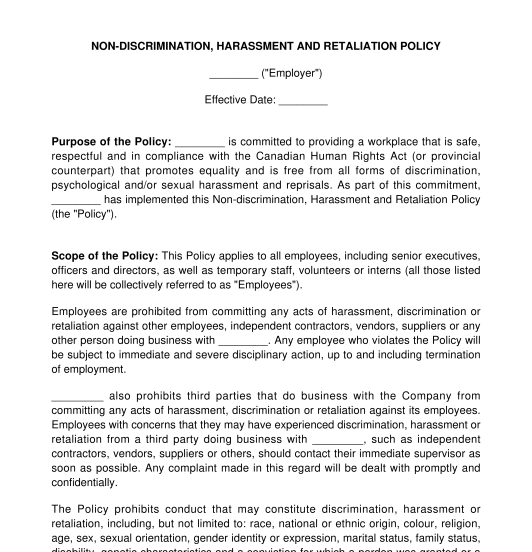 27/02/2025
27/02/2025

Answer a few questions and your document is created automatically.

Your document is ready! You will receive it in Word and PDF formats. You will be able to modify it.

 27/02/2025
27/02/2025
 Word and PDF
Word and PDF
 5 to 7 pages
5 to 7 pages
A policy to prevent discrimination, harassment and retaliation is a document used by employers to describe their specific rules on prohibited behaviour in the workplace. The document is important to any employer. Cases of discrimination, harassment or retaliation are the centre of many lawsuits. Having a policy in place protects employers and employees.
A hiring policy is a document that also describes how a company's management, who is in charge of hiring and onboarding new staff, is prohibited from basing their hiring practices on any of the prohibited grounds of discrimination. In other words, an employer cannot disqualify a prospective employee from the candidate pool as a result of either race, colour, place of origin, etc.
The difference between the hiring policy and a Non-Discrimination, Harassment and Retaliation Policy is that the hiring policy applies only at the hiring and onboarding level. In contrast, the Non-Discrimination, Harassment and Retaliation Policy applies throughout the employee's employment.
A Non-Discrimination, Harassment and Retaliation Policy should contain company identification information as well as information related to the definition of discrimination, harassment and retaliation. At a minimum, the policies need to outline that discrimination is prohibited on the following grounds:
A complaint or reporting procedure should also be outlined to help employees navigate difficulties in the workplace as a result of discrimination or harassment. The document should also list an investigation process so that the employer may properly examine any allegations of harassment or discrimination. Additionally, the document should outline the consequences of violating the policy, including a warning or termination as may be applicable.
Once the document is ready, it must be circulated to all employees for their review and signature. The employer can send this document via email to all staff or they may upload it to a common server for employee access.
Employees should sign the acknowledgement at the end of the document confirming they read and understand the Policy. The employer should then add a copy of the signed Policy to each employee's file.
In Canada, discrimination, harassment or retaliation against anyone who works for an organization is a violation of human rights law. Employers have an obligation to take appropriate action against any employee who discriminates or harasses someone. Employers can be held responsible for harassment by their employees if they don't act against it. Employees who report inappropriate behavior are also entitled to legal protection against retaliation.
The pieces of legislation per province and territory governing human rights law includes:
You fill out a form. The document is created before your eyes as you respond to the questions.
At the end, you receive it in Word and PDF formats. You can modify it and reuse it.
Country: Canada (English)